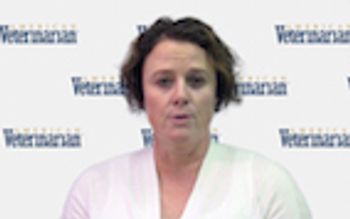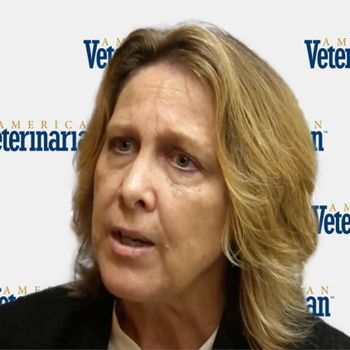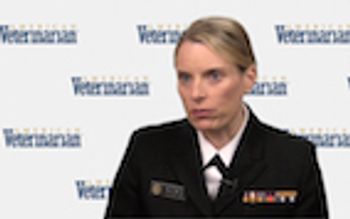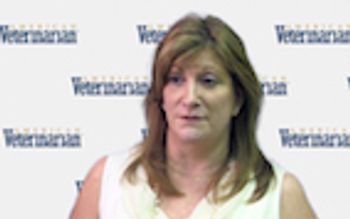
Valerie Fadok, DVM, PhD, DACVD, dermatologist in the Veterinary Specialty Team at Zoetis, discusses the diagnosis of dermatophytosis.

Valerie Fadok, DVM, PhD, DACVD, dermatologist in the Veterinary Specialty Team at Zoetis, discusses the diagnosis of dermatophytosis.

Meri Hall, RVT, CVT, LVT, LATG, VTS (SAM), veterinary technician of internal medicine, from Veterinary Specialty Hospital of Palm Beach Gardens, explains which non-bleach disinfectants would work against viruses.

Brian Faulkner, Bsc (Hons), BVM&S, CertGP (BPS), CertGP (SAM), MBA, MSc (Psych), MRCVS, explains the need for leaders to have someone in their corner to keep them honest about pace and progress.

Meri Hall, RVT, CVT, LVT, LATG, VTS (SAM), veterinary technician of internal medicine, from Veterinary Specialty Hospital of Palm Beach Gardens, talks about the different diseases that are preventable with proper disinfection.

Brian Faulkner, Bsc (Hons), BVM&S, CertGP (BPS), CertGP (SAM), MBA, MSc (Psych), MRCVS, reviews how body language and posture can make all the difference in delivering a memorable first impression.

Oh, those vexing veterinary dermatologic signs. Don't be fooled by them-examine samples first.

Valerie Fadok, DVM, PhD, DACVD, dermatologist in the Veterinary Specialty Team at Zoetis, discusses the best approach to advising a client who believes their pet may have infected them with dermatophytosis.

Brian Faulkner, Bsc (Hons), BVM&S, CertGP (BPS), CertGP (SAM), MBA, MSc (Psych), MRCVS, explains the difference between confidence and self-esteem.

An MBA/CVPM weighs in on what it takes to manage a clinic.

They've already done the hard part by getting invested in their pets' diets.

Anne Barger, DVM, MS, DACVP, clinical professor in pathobiology at University of Illinois, discusses the equipment that veterinarians need to perform in-house cytology in their practices.

Elke Rudloff, DVM, DACVECC, clinical specialist and residency trauma supervisor at Lakeshore Veterinary Specialists, outlines the initial approach to dealing with an emergency case in the veterinary setting.

Valerie Fadok, DVM, PhD, DACVD, dermatologist in the Veterinary Specialty Team at Zoetis, discusses the seasonality of dermatophytes.

Elke Rudloff, DVM, DACVECC, clinical specialist and residency trauma supervisor at Lakeshore Veterinary Specialists, explains who should be contacted if someone comes across injured wildlife.

Valerie Fadok, DVM, PhD, DACVD, dermatologist in the Veterinary Specialty Team at Zoetis, discusses how the management of canine atopic dermatitis has changed over the years.

Brian Faulkner, Bsc (Hons), BVM&S, CertGP (BPS), CertGP (SAM), MBA, MSc (Psych), MRCVS, discusses the requirement that leaders believe they have earned their right to lead.

Elke Rudloff, DVM, DACVECC, clinical specialist and residency trauma supervisor at Lakeshore Veterinary Specialists, explains the importance of pet owners contacting their veterinarian before transporting an injured pet.

Deborah Stone, MBA, PhD, CVPM, discusses what veterinarians can do to help each other in the fight against burnout and compassion fatigue.

Valerie Fadok, DVM, PhD, DACVD, dermatologist in the Veterinary Specialty Team at Zoetis, discusses the different factors that veterinarians should consider before diagnosing patients with atopic dermatitis.

They've shown an eagerness to train their petsjust point them in the right direction.

Elke Rudloff, DVM, DACVECC, clinical specialist and residency trauma supervisor at Lakeshore Veterinary Specialists, explains how veterinarians can evaluate if a patient has experienced neurological trauma.

Sinking effort into pre-planning will put your resources in the right hands.

Lauri A. Hicks, DO, captain, US Public Health Service, director, Office of Antibiotic Stewardship, medical director, Get Smart: Know When Antibiotics Work, Division of Healthcare Quality Promotion, Centers for Disease Control and Prevention, discusses why there should be local coalitions in each state that include both animal and human healthcare communities dedicated to fighting antibiotic resistance.

Lauri A. Hicks, DO, captain, US Public Health Service, director, Office of Antibiotic Stewardship, medical director, Get Smart: Know When Antibiotics Work, Division of Healthcare Quality Promotion, Centers for Disease Control and Prevention, explains how appropriate antibiotic use is a collective duty.

Lauri A. Hicks, DO, captain, US Public Health Service, director, Office of Antibiotic Stewardship, medical director, Get Smart: Know When Antibiotics Work, Division of Healthcare Quality Promotion, Centers for Disease Control and Prevention, explains how the fight against antibiotic resistance is part of the One Health initiative.

Money creates tension in veterinary hospitals between associates and owners. Dissolving that tension is no small feat, but CVC educators Denise Tumblin, CPA, and Ernie Ward, DVM, try in these two videos.

Diane Levitan, VMD, DACVIM, from Peace Love Pets Veterinary Care, explains that some dogs have a genetic predisposition to become hypothyroid.

Diane Levitan, VMD, DACVIM, from Peace Love Pets Veterinary Care, lists key points to take into account when diagnosing and treating canine hypothyroidism.

These two quick tips from Dr. Chen Gilor will help you more readily identify affected dogs.

Brian Faulkner, Bsc (Hons), BVM&S, CertGP (BPS), CertGP (SAM), MBA, MSc (Psych), MRCVS, explains the difference between an aggressive leader and an assertive leader.